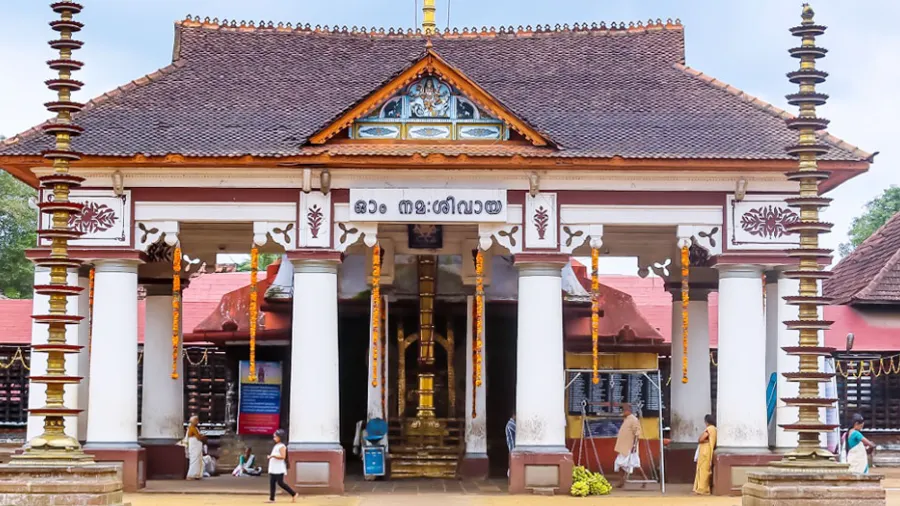Vaikom Mahadeva Temple History Mythology and Travel Guide
Prabhuling jiroli
Located in the Vaikom town of Kottayam district, Kerala, the Vaikom Mahadeva Temple is one of the oldest and most revered temples dedicated to Lord Shiva in India. Known for its spiritual significance and unique rituals, the temple is believed to be part of the “Vaikom-Ettumanoor-Kaduthuruthy” Shiva triangle, which holds immense importance for devotees.
In this blog, we will explore the history, mythology, cultural importance, and travel tips for visiting the Vaikom Mahadeva Temple.
History of Vaikom Mahadeva Temple

The origins of the Vaikom Mahadeva Temple date back over 1,500 years, making it one of the oldest Shiva temples in South India. Historical records suggest that the temple was established during the Treta Yuga, when Lord Parasurama is believed to have consecrated the Shivalinga.
The temple has witnessed numerous renovations and expansions over the centuries. The temple played a pivotal role in India’s freedom struggle during the Vaikom Satyagraha (1924-1925), led by Mahatma Gandhi and other prominent leaders. This movement was a fight for social equality, allowing lower-caste people to enter the temple.
Mythology Behind Vaikom Mahadeva Temple
According to Hindu mythology, the Shivalinga enshrined at Vaikom Mahadeva Temple was blessed by Lord Shiva himself. It is believed that Kharasura, a demon, was a devotee of Lord Shiva. He worshipped the Shivalinga at three different locations: Vaikom, Ettumanoor, and Kaduthuruthy.
The Shivalinga at Vaikom is considered the most powerful manifestation of Lord Shiva in the region. The temple is also believed to fulfill the wishes of devotees, especially those seeking health and prosperity.
Another legend states that Lord Parasurama, an incarnation of Lord Vishnu, consecrated the Shivalinga at Vaikom Mahadeva Temple, making it a holy site for Hindus.
Architectural Significance
The Vaikom Mahadeva Temple showcases traditional Kerala-style architecture with intricate carvings, massive wooden doors, and copper-clad roofs. The sanctum sanctorum (Sreekovil) houses the Shivalinga, which is believed to be self-manifested.
Key architectural highlights include:
- Nadapanthal: The pathway leading to the sanctum, supported by massive stone pillars.
- Gopuram: The entrance tower adorned with intricate sculptures.
- Balikalpura: The place where sacrificial offerings are made.
- Koothambalam: A performance hall where ritual dances are performed.
Vaikom Satyagraha: A Fight for Equality
The Vaikom Satyagraha (1924-1925) was a historic movement led by Mahatma Gandhi and other leaders to end the caste-based discrimination at the temple. The movement aimed to allow lower-caste people to enter the temple and was one of the first organized efforts for social reform in Kerala.
The success of the Vaikom Satyagraha paved the way for social equality and temple entry reforms in Kerala.
How to Reach Vaikom Mahadeva Temple
By Air:
The nearest airport is Cochin International Airport, located about 56 km from Vaikom.
By Train:
The nearest railway station is Vaikom Road Railway Station, which is about 10 km from the temple.
By Road:
Vaikom is well-connected by road, and the temple can be easily reached by bus, car, or taxi from nearby towns and cities.
When to Visit Vaikom Mahadeva Temple
The best time to visit the temple is during the Vaikathashtami festival, which falls in November-December. The festival is celebrated with great fervor, featuring rituals, processions, and traditional performances.
For a peaceful experience, visit the temple during the winter months (October to February) when the weather is pleasant.
Travel Tips for Visiting Vaikom Mahadeva Temple
- Dress Code: Visitors are required to wear traditional attire. Men should wear a dhoti, and women should wear a saree or salwar kameez.
- Temple Timings: The temple is open from 4 AM to 12 PM and 5 PM to 8 PM.
- Photography: Photography is not allowed inside the temple premises.
- Offerings: Devotees can offer coconuts, flowers, and oil lamps to Lord Shiva.
- Guided Tours: Hire a local guide to learn more about the temple’s history and significance.